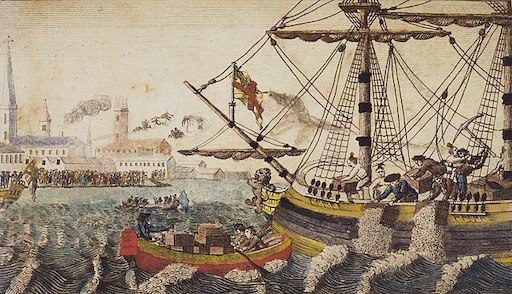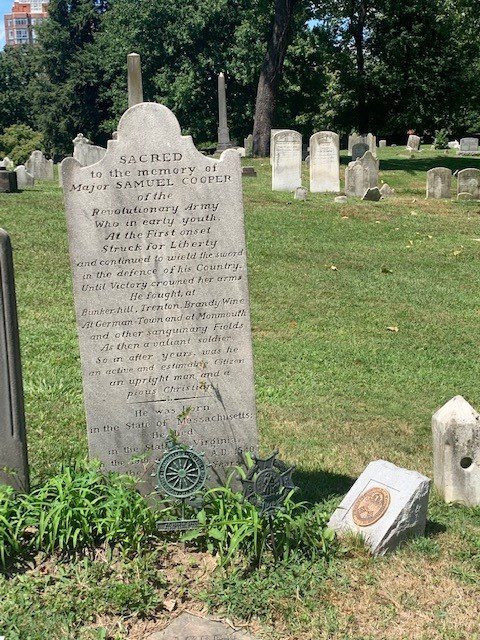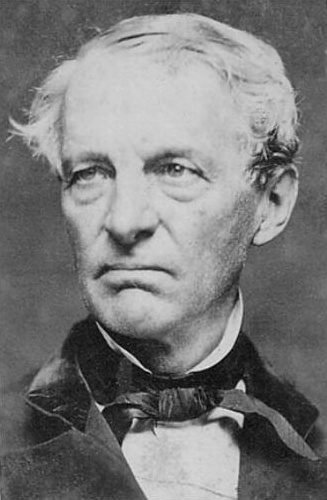Buried in Alexandria’s Christ Church Cemetery is Major Samuel Cooper. He lived from June 13, 1757, to August 19, 1840. When he was 16 years old, he participated in the Boston Tea Party on December 16, 1773, as a member of the Sons of Liberty. During the event, they threw over 340 tea chests (92,000 pounds) from three ships, namely the Dartmouth, Eleanor, and Beaver, onto the docks or into the Boston Harbor. Cooper is one of the four people known to have written about that night.
Paul Revere, another notable participant (January 1, 1735 – May 10, 1818), was later buried in Boston’s Granary Burial Ground. (To find the complete list of people who participated in the Boston Tea Party, visit this website: http://www.boston-tea-party.org/participants/participants.html)

The Boston Tea Party – As written by Samuel Cooper
“The duty on tea gave great umbrage to the colonists generally and in Boston an association was formed in 1770 to drink no tea until the duty was repealed. This course was persisted in 1773 the arrival of 3 ships from England laden with tea caused great disgust.”
“No little excitement prevailed among the inhabitants of Boston, on account of the arrival of the ships laden with tea from England. Every effort was made to send these ships back but without success and it was soon evident that the tea would be landed unless some active measures were adopted by the citizens to prevent it. A town meeting was called on the afternoon of December 16, 1773 to devise measures for getting rid of this annoyance. At this meeting, which was held in the Old South Meeting House corner of Main and Milk Street, Jno. Hancock presided.“
“A little before sundown an alarm was created among the assembled citizens by the cry of fire, which was suppose to be given by some of the British officers who had attended the meeting in citizen dress and had given the alarm for the purpose of breaking up the assembly. They had nearly effected this object when the town clerk, Wm. Cooper rose and in a loud voice told the citizens that there was no fire to be apprehended but the fire of the British and begged them to keep their plaices.“
“Immediately after a detach’t of about 20 men disguised as Indians was seen to approach in single file by the west door of the Church. They marched with silent steps down the isle and so passed by the south door brandishing their tommahaws [tomahawks] in that direction. The appearance of these men created some sensation. No one appeared to expect their arrival and the object of their visit seemed wholly inexplicable. On leaving the church, they proceeded in the same order in which they entered it, down Milk Street through that part of town which led to Gray’s and Tiletson’s wharves where the tea ships lay.“
“Arrived at the wharves they divided into three troops each with a leader gained possession of the ships quietly and proceeded to lighten them of their cargo by hoisting out the boxes and emptying their contents into the dock. No noise was heard except the occasional clink of the hatchet in opening the boxes and the whole business was performed with so much expedition that before 10 o’clock that night the entire cargo of the three vessels were deposited in the docks.“
“Many a wishful eye was directed to the piles of tea which lay in the docks and one poor fellow (5) who could not resist the temptation had filled the lining of his cloak with about a bushel of the plants. He was soon observed by the crowd and the process of lightening him of his burden was short. He was dragged a little distance on the wharf to a barrel and was soon furnished with a coat of tar and shavings.“
“The Shot Heard Around the World!”
The Boston Tea Party prompted the British to declare Boston under military control. This escalation eventually led to the Battles of Lexington and Concord on April 19, 1775, after British forces attempted to seize colonial weapons stored in Concord. According to some accounts, Samuel Cooper was among the American volunteers who answered the call to arms after Paul Revere, Samuel Prescott, and William Dawes warned the countryside. These skirmishes marked the start of the eight-year Revolutionary War that culminated in the colonies’ independence.

Cooper’s Revolutionary War Record
During the war, Samuel Cooper fought in several key battles, including:
- Monmouth (June 28, 1778)
- Bunker Hill (June 17, 1775)
- Trenton (January 1777)
- Brandywine (September 11, 1777)
- Germantown (October 4, 1777
Cooper rose through the ranks and was commissioned as a second lieutenant in Crane’s artillery regiment on February 1, 1777. He later served as quartermaster (1778) and adjutant (1783). After the war, he was inspector of pot and pearl ashes in New York City and county from 1808 to 1830.
In 1830, Cooper retired and moved to Georgetown, D.C. A decade later, on August 19, 1840, he passed away and was buried in Christ Church Cemetery in Alexandria. His gravestone reads:
| Sacred to the memory of MAJOR SAMUEL COOPER of the Revolutionary Army Who in early youth At the First onset Struck for Liberty and continued to wield the sword in the defence of his Country Until Victory Crowned her arms He fought at Bunker-Hill, Trenton, Brandy-Wine At German-Town and at Monmouth and other sanguinary Fields. As then a valiant soldier So in afterlife, was he an active and estimable Citizen an upright man and a pious Christian He was born in the State of Massachusetts, He died in the state of Virginia on the 19th of August A.D. 1840 At the age of 84 Years. |

Cooper’s gravesite features his original headstone and a newer marker, accompanied by D.A.R. and S.A.R. plaques.
Family Legacy
Buried alongside Major Cooper is his son, Samuel Cooper (June 12, 1798 – December 3, 1876), who became the highest-ranking officer in the Confederate Army during the Civil War. Samuel Cooper’s descendants include Sarah Maria Cooper Wheaton, Major Samuel Cooper Jr., and Virginia Mason Cooper Dawson, all of whom have notable resting places. The family’s home, Cameron, was destroyed during the Civil War to make way for Fort Williams, a Union stronghold.

Sources of Information
Boston Tea Party Historical Society. (2022). Samuel Cooper [Record]. Retrieved from the Boston Tea Party Historical Society official website.
Daughters of the American Revolution. (2022). Genealogy Research. [Official Website]. Retrieved from the Daughters of the American Revolution website, accessed 2022.
Drake, F. S. (1884). Tea Leaves: Being a Collection of Letters and Documents Relating to the Shipment of Tea to The American Colonies in the Year 1773, By the East Indian Tea Company. Now First Printed From the Original Manuscript. With an Introduction, Notes, and Biographical Notices of the Boston Tea Party. A. O. Crane: Boston.
Kundahl, G. (2004). Alexandria Goes to War: Beyond Robert E. Lee. The University of Tennessee Press.
Newport News Daily Press. (2001, May 15). Article about General Samuel Cooper. p. 5. Accessed 2023.
Pippenger, W. E. (1992). Tombstone Inscriptions of Alexandria, VA (Volume 3). Family Line Publications: Westminster, Maryland.
Powell, M. G. (2000). The History of Old Alexandria, VA, from July 13, 1749 – May 24, 1861. Index by Pippenger, W. E. Willow Bend Books: Westminster, Maryland.
The Alexandria Association. (1956). Our Town 1749 – 1865. The Dietz Printing Company: At Gadsby’s Tavern Alexandria, Virginia.
The City of Alexandria Archeology Department. (n.d.). Archaeological investigation report on 206 North Quaker Lane (44AX193). Retrieved from The City of Alexandria Archeology Department official website. [URL] The Report was accessed in 2022.